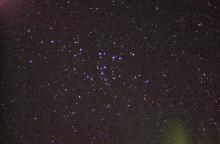Listen to today's episode of StarDate on the web the same day it airs in high-quality streaming audio without any extra ads or announcements. Choose a $8 one-month pass, or listen every day for a year for just $30.
You are here
Messier 53
From the globular star cluster Messier 53, the view would be spectacular. The cluster floats high above the disk of the Milky Way Galaxy. So the entire galaxy would spread out below it — from the graceful spiral arms to the star-packed core.
M53 orbits the core, so it’s a member of the galaxy. But that might not always have been the case. Studies have suggested that it was born in another galaxy — perhaps as the galaxy’s core. Billions of years ago, that galaxy was pulled in by the Milky Way’s powerful gravity. Most of its stars were stripped away and absorbed by the Milky Way’s disk. But M53 stayed in the halo — a vast region that surrounds the disk.
Today, the cluster is perhaps 60,000 light-years from the core — and about the same distance from Earth. But its orbit carries it up to twice as far from the galaxy’s heart.
The view inside the cluster would be spectacular as well. M53 contains hundreds of thousands of stars. Most of them are packed into a ball only a few dozen light-years across. So the night sky of a star inside the system would glow with many more bright stars than our own sky. That would make the view from M53 doubly impressive — stars all around, and the Milky Way below.
Messier 53 is in the constellation Coma Berenices. The cluster is well up in the east at nightfall, and is an easy target for binoculars. It’s easier to see by around midnight, as the Moon drops from view.
Script by Damond Benningfield





